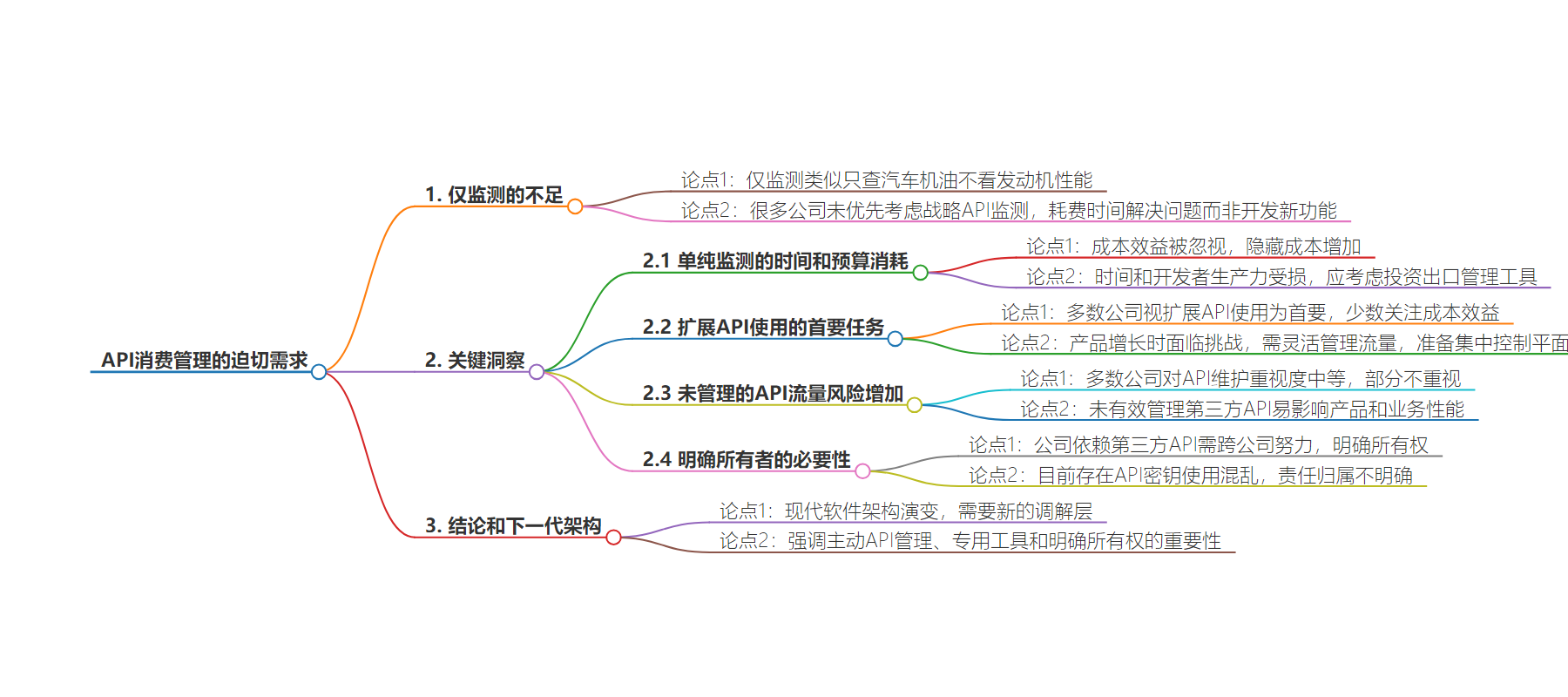包阅导读总结
关键词:
`API 消费管理、战略方法、风险成本、优化扩展、明确所有权`
总结:
本文强调随着 AI 发展及对 API 依赖增加,仅靠监控不够,需战略的 API 消费管理。指出当前存在忽视战略监测、成本和时间浪费、扩展困难、管理不善风险、所有权不明等问题,并提出应投资工具、优化成本、准备控制平面、明确所有者等解决方法,还提到软件架构需新的调解层来管理 API 消费。
主要内容:
– 背景
– 软件架构需适应 AI 带来的 API 使用增长。
– 仅监控如只查机油不看引擎性能。
– 问题
– 许多组织未优先战略监测 API 消费。
– 单纯监控造成时间和预算浪费。
– 扩展 API 使用面临挑战。
– 未管理的 API 流量带来风险。
– 缺乏明确的 API 所有权。
– 解决方法
– 投资管理工具优化成本和识别瓶颈。
– 准备中心化控制平面灵活扩展。
– 明确 API 所有者。
– 未来展望
– 软件架构需新调解层管理 API 消费。
思维导图:
文章地址:https://thenewstack.io/beyond-monitoring-the-urgent-need-for-strategic-api-consumption-management/
文章来源:thenewstack.io
作者:Eyal Solomon
发布时间:2024/8/28 13:50
语言:英文
总字数:753字
预计阅读时间:4分钟
评分:83分
标签:API 管理,AI 集成,API 使用,API 治理,安全风险
以下为原文内容
本内容来源于用户推荐转载,旨在分享知识与观点,如有侵权请联系删除 联系邮箱 media@ilingban.com
Software architecture must swiftly adapt to the soaring usage of AI. Relying solely on monitoring is like checking the oil in a car without ever considering the engine’s performance. With the rapid rise of AI and increased dependence on APIs, companies need more than just oversight — they need a strategic, proactive approach to API consumption management. Despite being API-savvy, many companies struggle to keep up, often wasting valuable developer time on inefficiencies hidden in their day-to-day operations.
A recent survey from Lunar.dev’s “2024 State of API Consumption Management” report reveals that many organizations fail to prioritize strategic API monitoring. Without the right tools, 36% of companies spend more time troubleshooting APIs than developing new features. This neglect introduces security risks, hampers performance, and inflates operational costs, making dedicated API management tools beneficial and essential.
Here are a few key insights from the report that indicate a bigger problem:
The Time and Budget Drain of ‘Simply Monitoring’
The survey highlights a stark reality: While cost-effectiveness is a significant advantage, many companies overlook it. The hidden API maintenance and troubleshooting costs — especially with AI and LLM APIs — add up quickly.
Time and developer productivity are the biggest casualties, with 54% of companies dealing with API issues weekly, and 33% daily.
Organizations should consider investing in egress management tools to gain visibility into patterns to optimize costs and identify potential bottlenecks.
Scaling API Usage: The Top Priority
Fifty-seven percent of companies consider scaling API usage their primary concern, while only 15% identify cost-effectiveness as a significant challenge in API consumption.
As products grow and consumption rises, challenges become more pronounced, especially during peak traffic. Companies need greater flexibility to manage these traffic surges but often face constraints due to rate limits and costs.
Organizations must be prepared and aware of the benefits of a centralized control plane for managing and governing all outbound API traffic to scale API consumption flexibly as needed. This must be done to increase awareness of third-party API consumption with a minimal footprint.
To conclude, the more governance there is, the more granularity on external traffic there is, and the more control and clarity there is internally.
The Growing Risk of Unmanaged API Traffic
Only 33% of companies ranked API maintenance as a high or very high priority, 5% marked it as a non-priority, and 62% as moderate.
By not prioritizing the maintenance and optimization of their API integrations, companies are more vulnerable to unsafe API consumption.
Companies that aren’t currently managing their third-party APIs effectively may be jeopardizing the performance of their products and, consequently, business performance as well.
This lack of concern is perhaps why “API10:2023 – Unsafe Consumption of APIs” is now on the OWASP top ten. Unsafe consumption is a growing concern since it’s becoming a prominent supply chain attack, and developers do not have adequate proactive measures to enforce security on API consumption.
There Needs To Be a Clear Owner
Like with many things in organizations, there needs to be clear ownership to excel.
As companies continue to evolve in their reliance on and usage of third-party APIs, driven by AI advancements, managing and optimizing APIs will increasingly require a cross-company effort rather than being confined to a specific application or integration team.
Currently, many companies are using duplicate API keys across various environments and services, leading to unclear ownership.
When asked who is responsible for resolving API integration problems, responses were split between the platform team, the integration team, and the application engineer. Moreover, most companies selected multiple options, including team leads, DevOps, individual contributors, etc., indicating a need for clear ownership.
API consumption impacts product development, business operations, and engineering productivity. Building a comprehensive API stack within a company will necessitate a clear owner.
Conclusions and the Next Gen of Architecture
The architecture of modern software is evolving.
As companies evolve into a “thinner” backend infrastructure but rely much more on third-party API integrations, the need for a new mediation layer becomes apparent. Just as API gateways rose to mediate between customers and API providers, a similar evolution is required to manage the APIs that applications consume.
The overlooked risks and costs of API consumption underscore the need for proactive API management, dedicated tools, and clear ownership. Companies must shift their approach to understand where API consumption fits within their overall architecture and build with these considerations in mind.
YOUTUBE.COM/THENEWSTACK
Tech moves fast, don’t miss an episode. Subscribe to our YouTubechannel to stream all our podcasts, interviews, demos, and more.
